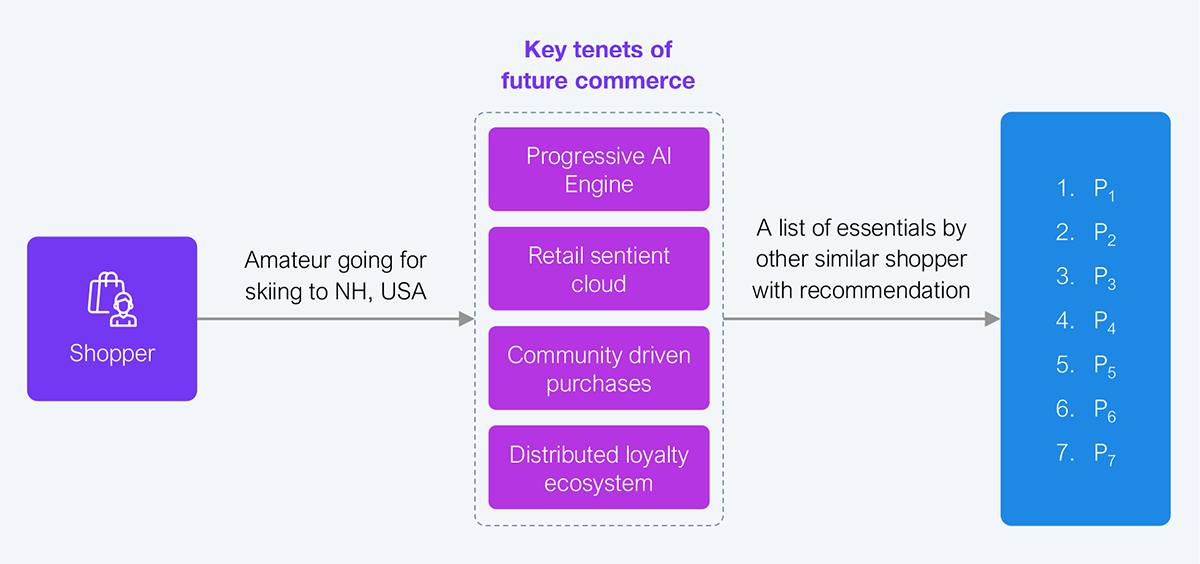The e-commerce channel has been the cornerstone of retail growth in the United States for the past 15 years, almost doubling every five years. However, the touchpoints and structure of the shopping journey, essentially the path to purchase, remain fundamentally unchanged since the inception of online retailing.
These frameworks, built on limited technological resources such as 2G bandwidth and nascent cloud capabilities, constrain the potential for innovation. However, in the next 18 to 24 months, AI is set to revolutionize the online shopping experience, breaking free from decades-old paradigms. The impending AI-powered paradigm will redefine how shoppers interact with e-commerce platforms, offering intuitive and personalized experiences that mirror real-world shopping.
The traditional e-commerce workflows (see Exhibit 1)—from category navigation to product listing and checkout—remain deeply ingrained but fail to replicate the nuanced, consultative, and intuitive nature of physical shopping experiences.

Source: HFS Research, 2025
In the past 15 or so years, retailers have made multiple improvements by integrating new user experience patterns into the existing (and ancient) e-commerce workflow (see Exhibit 2). At each stage, new levers help the customer reach the final stage faster. For instance, retailers now have a personalized homepage that carries suggestions based on a shopper’s past browsing and purchase history. Similarly, on the product description page, the shopper can read actual customer purchase and usage reviews, understand the pros and cons, and make an informed decision.

Source: HFS Research, 2025
While impressive, this e-commerce ‘shopping experience’ growth trajectory has plateaued in its ability to deliver transformative shopper experiences. The reliance on static, catalog-based approaches has entrenched inefficiencies, placing the burden of product discovery, comparisons, and decision-making squarely on the shopper.
The current e-commerce journey was conceived during an era of technological infancy. In 2010, shoppers navigated slow-loading pages over 2G or 3G connections, accessed limited product information, and relied on rudimentary search algorithms. Despite the evolution of supporting technologies, such as the proliferation of smartphones and the advent of social commerce, the core experience remains static. The focus has primarily been about optimizing existing models rather than reimagining them.
Among its most significant shortcomings, the current model doesn’t replicate real-world buying patterns. The burden of product and pricing research is on the shopper. Most importantly, the shopper search often begins with a goal, but then the shopper works backward to find products. Let’s explain this with an example.
The requirement: Remodel your home office.
The process: The shopper determines what items to purchase based on budget and requirements, searches for those items across leading marketplaces and retailer sites, performs price and product comparisons, makes individual cart selections, and places an order.
The challenge: Ideally, the shopper would want to express wishes, goals, and objectives and, in return, receive meaningful product or service recommendations.
AI introduces a dynamic shift by transforming the linear, shopper-led e-commerce journey into an intuitive, goal-driven experience. Imagine a shopper expressing a simple goal: “I am an amateur who wants to go skiing, and my budget is less than $1,000.” AI-powered platforms will interpret this intent, leveraging contextual data, historical preferences, and advanced recommendation systems to curate a tailored shopping experience.
HFS has created a futuristic model (see Exhibit 3) illustrating how this could unfold.

Source: HFS Research, 2025
Early adopters can gain a significant competitive advantage by offering experiences that transcend traditional e-commerce limitations. Platforms that understand and anticipate shopper needs at a granular level will shape the future of online shopping.
AI isn’t just enhancing the e-commerce experience; it is rewriting the rulebook. The transition from transactional to intuitive commerce promises unprecedented convenience and personalization. The current e-commerce journey, though historically effective, is no longer adequate in a world driven by immediacy and personalization. With AI at the helm, the next phase of e-commerce will be less about navigating products and more about fulfilling goals—a shift that will change how we shop and perceive the role of commerce in our lives.
Register now for immediate access of HFS' research, data and forward looking trends.
Get StartedIf you don't have an account, Register here |
Register now for immediate access of HFS' research, data and forward looking trends.
Get Started